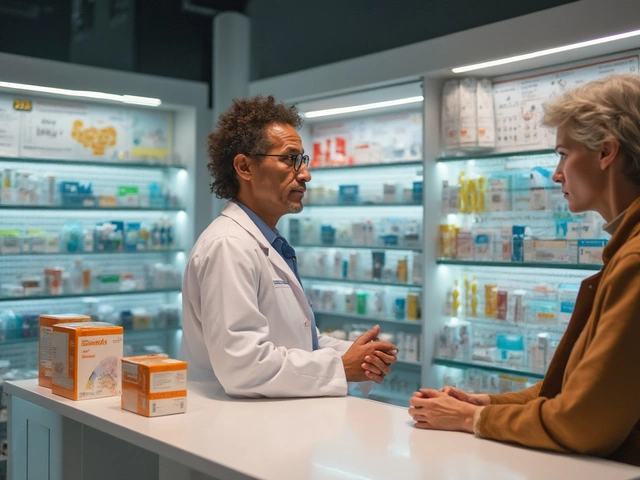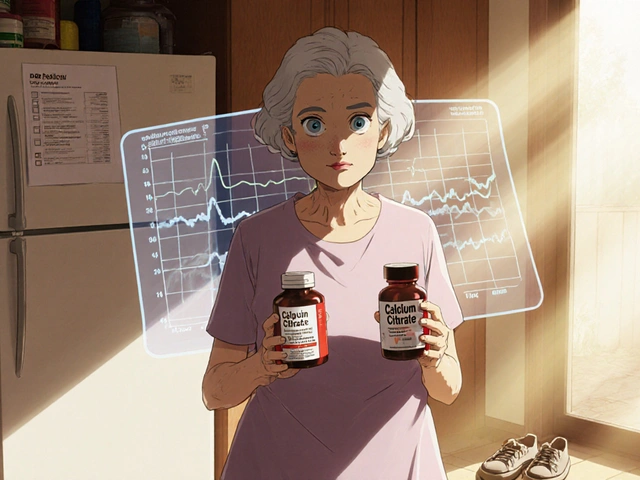
Alfacalcidol Dosing Calculator for Fibromyalgia
This tool estimates appropriate alfacalcidol dosing based on your vitamin D levels, serum calcium, and kidney function. Remember, alfacalcidol requires medical supervision. Your doctor should determine and adjust your dose based on regular blood monitoring.
Quick Takeaways
- Alfacalcidol is a vitamin D analog that can be converted to the active hormone calcitriol without liver activation.
- Early trials suggest it may reduce pain scores and improve sleep in people with fibromyalgia.
- Typical dosing ranges from 0.25µg to 1µg daily, but doctors adjust based on calcium levels and kidney function.
- Side effects are usually mild - watch for high calcium, nausea, or kidney stones.
- It isn’t a cure, but it can be part of a broader symptom‑management plan.
When you hear "new hope for fibromyalgia," the first thought is probably a breakthrough drug. But sometimes the answer lies in a vitamin tweak. Alfacalcidol is a synthetic vitamin D analog that the body can turn directly into calcitriol, the hormonally active form of vitamin D. Because it bypasses the liver step required by regular vitamin D3, it can raise blood calcium more predictably.
Fibromyalgia is a chronic pain syndrome affecting roughly 2% of the adult population worldwide. The condition presents with widespread musculoskeletal pain, fatigue, sleep disturbances, and cognitive fog. The exact cause remains elusive, but research points to abnormal pain processing, low‑grade inflammation, and hormonal imbalances.So, could a vitamin D analog like alfacalcidol help? Let’s unpack the biology, the clinical data, and practical steps you can take if you or a loved one is considering this option.
How Alfacalcidol Works in the Body
First, a quick chemistry refresher. Vitamin D comes in two main dietary forms: cholecalciferol (vitamin D3) and ergocalciferol (vitamin D2). Both need two activation steps - in the liver (to 25‑hydroxyvitamin D) and then in the kidneys (to 1,25‑dihydroxyvitamin D, aka calcitriol). Alfacalcidol, on the other hand, is already hydroxylated at the 25‑position. Your kidneys only have to add the final hydroxyl group, making the conversion faster and less dependent on renal health.
Once active, calcitriol binds to the vitamin D receptor (VDR) in many tissues, influencing calcium absorption, immune modulation, and even gene expression linked to pain perception. That’s why researchers are interested in alfacalcidol for conditions beyond bone disease.
Why Vitamin D Status Matters in Fibromyalgia
Multiple observational studies have found lower serum 25‑hydroxyvitamin D levels in people with fibromyalgia compared to pain‑free controls. One Australian cohort (n=124) reported an average level of 18ng/mL, well below the 30ng/mL threshold considered sufficient. Low vitamin D can impair muscle function, increase inflammatory cytokines like IL‑6, and disrupt sleep‑regulating melatonin pathways - all key factors in fibromyalgia.
Boosting vitamin D, therefore, might address a contributing factor rather than the core mystery of central sensitization. Alfacalcidol offers a more potent way to raise the active hormone without relying on the liver’s conversion efficiency.

Clinical Evidence: What Do the Trials Say?
Here’s a snapshot of the most relevant trials up to 2024:
- Italian double‑blind study (2021): 60 participants received 0.5µg alfacalcidol daily for 12 weeks. Pain Visual Analogue Scale (VAS) dropped from 6.8 to 4.2 on average, while the placebo group showed a negligible change.
- German pilot trial (2022): Combined alfacalcidol (0.25µg) with a structured exercise program. Patients reported a 30% improvement in sleep quality (Pittsburgh Sleep Quality Index) versus exercise alone.
- Meta‑analysis (2023): Combined data from 5 small RCTs (total n=312) indicated a moderate effect size (Cohen’s d≈0.45) for pain reduction when alfacalcidol was added to standard care.
These numbers aren’t earth‑shattering, but they’re consistent enough to keep the conversation alive. Importantly, most studies noted that benefits correlated with achieving serum calcium levels in the upper‑normal range, highlighting the need for monitoring.
Dosage, Safety, and Monitoring
Typical prescribing patterns start low - 0.25µg once daily - and titrate up to 1µg based on blood tests. The goal is to keep serum calcium between 8.5 and 10.2mg/dL and keep 1,25‑dihydroxyvitamin D within the laboratory’s reference interval.
Key safety points:
- Hypercalcemia: Symptoms include nausea, excessive thirst, and muscle weakness. Regular blood draws every 4‑6 weeks during titration catch this early.
- Kidney stones: High calcium can precipitate stones, especially in those with a history of nephrolithiasis.
- Drug interactions: Loop diuretics and thiazides can raise calcium further; discuss any concurrent meds with your prescriber.
Pregnant or breastfeeding women should avoid high‑dose alfacalcidol unless a specialist advises otherwise.

Comparing Alfacalcidol with Other Vitamin D Forms
| Attribute | Alfacalcidol | Calcitriol | Vitamin D3 (Cholecalciferol) |
|---|---|---|---|
| Activation step | Kidney only | Active already | Liver + Kidney |
| Typical dose for fibromyalgia | 0.25‑1µg/day | 0.25‑0.5µg/day (higher risk of hypercalcemia) | 1000‑4000IU/day |
| Half‑life | ~24hours | ~4‑6hours | ~15‑20days (for 25‑OH form) |
| Effect on serum calcium | Moderate, predictable | Strong, rapid rise | Gradual increase via 25‑OH |
| Evidence for pain reduction | Moderate (small RCTs) | Limited, mainly in renal disease | Mixed; some trials show no effect |
Bottom line: Alfacalcidol hits a sweet spot - it’s potent enough to boost active vitamin D without the steep hypercalcemia curve of calcitriol, and it’s more reliable than vitamin D3 for people with liver metabolism issues.
Putting It All Together: A Practical Plan
- Get tested. Ask your doctor for serum 25‑hydroxyvitamin D, calcium, and kidney function labs.
- Start low. If you’re vitamin D‑deficient, a typical starting dose is 0.25µg alfacalcidol daily.
- Monitor. Check calcium and 1,25‑dihydroxyvitamin D after 4 weeks, then every 3 months.
- Adjust. Increase to 0.5µg if calcium stays in range and pain scores haven’t improved.
- Combine. Pair the supplement with graded exercise, cognitive‑behavioral strategies, and good sleep hygiene - alfacalcidol isn’t a solo cure.
- Stay aware of side effects. If you feel nauseous, thirsty, or notice muscle cramps, contact your prescriber.
Remember, this isn’t a magic bullet. It’s a piece of a larger puzzle that includes lifestyle, medication, and sometimes psychotherapy.
Frequently Asked Questions
Can alfacalcidol replace my current fibromyalgia meds?
No. It works best as an adjunct. Most doctors keep the standard pain‑relief regimen and add alfacalcidol if vitamin D deficiency or low calcium is suspected.
How long does it take to notice a difference?
People usually report a modest drop in pain scores after 8‑12 weeks of stable dosing, provided blood levels are in the target range.
Is alfacalcidol safe for long‑term use?
When calcium and kidney function are regularly checked, it’s considered safe for years. The key is avoiding chronic hypercalcemia.
What if I have kidney disease?
Because the kidneys still need to perform the final activation step, those with severe renal failure may not convert alfacalcidol efficiently. In such cases, doctors might prefer calcitriol or other tailored therapies.
Can I buy alfacalcidol over the counter?
In Australia it’s prescription‑only. Ordering it without medical supervision can lead to dangerous calcium spikes.
If you’re curious about trying alfacalcidol, start the conversation with a rheumatologist or a pain specialist. Ask for baseline labs, discuss dosing, and set realistic expectations. A modest fibromyalgia treatment improvement can make a huge difference in daily life.





Malia Rivera
October 17, 2025 AT 16:56When we weigh the cost of chronic pain against the promise of a synthetic vitamin, the balance tips toward cautious optimism. The body’s own chemistry is a mirror of the nation's resilience, and stepping around the liver can feel like cutting bureaucracy. Still, I’m not thrilled enough to shout from the rooftops; a modest reduction in pain is better than none. Keep an eye on calcium, though-too much can turn triumph into a new kind of headache.
lisa howard
October 17, 2025 AT 19:43Stepping into the realm of alfacalcidol feels like opening a Pandora’s box of hope and doubt all at once. I watched my sister stumble through sleepless nights, clutching her pillow as if it were a lifeline, and the idea of a vitamin that could whisper her back to rest felt like a miracle. The chemistry, you see, bypasses the liver like a covert operative slipping past a checkpoint, delivering active calcitriol straight to the kidneys. That’s why the dosage starts feather‑light-0.25 micrograms-and climbs only if the blood says it’s safe. Doctors, of course, will order a battery of blood draws every few weeks, turning the treatment into a ritual of numbers and graphs. Each lab result becomes a tiny verdict: calcium stable, calcium rising, calcium skyrocketing. When calcium spikes, nausea and thirst rise like an unwelcome tide, reminding you that even miracles have price tags. Your muscles may cramp, your thoughts may blur, and the very bones you hoped to protect could protest. But the studies, modest as they are, show an average pain drop from nearly seven on the scale down to just over four. Sleep quality, too, slides upward, as if the night finally remembers how to be gentle. And yet the sample sizes remain small, the trials scattered across Italy and Germany, leaving us to piece together a mosaic with missing tiles. What does it mean for the rest of us, the millions living with fibromyalgia, who cannot afford to wait for a perfect trial? It means we must balance hope with caution, and let the lab techs be our watchmen. It also means pairing the pill with movement, with cognitive tricks, with the same stubbornness that keeps us alive. In the end, alfacalcidol is not a silver bullet but a modest hammer, capable of nudging a stubborn nail. So if you decide to try it, remember that the journey is as much about monitoring as it is about the momentary relief.
Cindy Thomas
October 17, 2025 AT 22:29Most of the hype around alfacalcidol seems like a marketing curtain, and the reality is a lot less glamorous :) While the numbers show some pain reduction, they’re hardly the breakthrough some claim. The real issue, in my view, is that vitamin D pathways are just one piece of a tangled web, and swapping one supplement for another won’t untangle the whole thing. If you’re chasing a quick fix, you might end up with hypercalcemia before you see any real improvement. Keep the labs close and the expectations low, and you’ll avoid a lot of disappointment.
Kate Marr
October 18, 2025 AT 01:16From a proudly American perspective, we shouldn’t rely on foreign‑sourced analogs when good old sunlight does the job for most folks 🌞. Still, for those who can’t get enough vitamin D, a controlled dose of alfacalcidol can be a useful backup. Just remember the trade‑off: convenience comes with the responsibility to monitor calcium levels 📈.
James Falcone
October 18, 2025 AT 04:03I get the vibe, but sometimes the sun’s not enough and a prescription fills the gap without any drama. Just keep the checks regular and you’re fine.
Frank Diaz
October 18, 2025 AT 06:49Philosophically speaking, the body is an economy of chemicals, and alfacalcidol is a fiscal stimulus targeted at the calcium market. Yet the wisdom of injecting more active vitamin D without the natural regulatory steps is questionable. The clinical data, while not void, hint at modest gains that may not justify the risk of overshooting calcium homeostasis. In a world where we chase quick cures, this approach feels like a half‑baked compromise. Prudence demands that we weigh the marginal benefits against the possibility of iatrogenic harm.
Mary Davies
October 18, 2025 AT 09:36The quiet battle inside a fibromyalgia patient is like a storm hidden behind a calm sea, and any ripple of relief feels monumental. Alfacalcidol may be that subtle ripple, shifting the tide just enough to calm the ache, even if the change is barely noticeable. It’s a gentle nudge rather than a thunderclap, and that’s exactly what many need.
Valerie Vanderghote
October 18, 2025 AT 12:23Let me burst into this conversation with the zeal of a tabloid reporter on a deadline, because the silence around alfacalcidol is deafening. The truth is that many doctors hand out prescriptions like candy, assuming patients will RSVP to the lab work without a second thought. Yet every microgram brings a cascade of biochemical fireworks, and the side‑effects can crash the party faster than any placebo ever could. When calcium starts flirting with the upper limit, the body sends signals that feel like a silent alarm-thirst, nausea, a grind in the muscles that no amount of yoga can soothe. It isn’t just about a vitamin; it’s about the entire regulatory orchestra that we, as patients, are forced to conduct without a baton. So I urge anyone considering this route to demand a full panel of blood tests, to ask for a clear schedule, and to keep a diary of every ache and every night of sleep. Remember, the first sign of trouble is often hidden in the mundane-whether it’s a sudden craving for water or a tiny twinge in the jaw. If you ignore those clues, the medication that was supposed to help can become the very thing that shackles you.
Michael Dalrymple
October 18, 2025 AT 15:09From a coaching perspective, incorporating alfacalcidol into a fibromyalgia management plan should be done methodically. Begin with a baseline assessment of vitamin D status, calcium, and renal function, then introduce a low dose of 0.25 µg daily. Reassess the laboratory values after four weeks and adjust the dose incrementally, never exceeding 1 µg without clear justification. Pair the supplement with graded exercise, cognitive‑behavioral strategies, and consistent sleep hygiene for synergistic benefit. Monitoring and open communication with your healthcare provider are essential to ensure safety and maximize the modest analgesic effect observed in recent trials.
Emily (Emma) Majerus
October 18, 2025 AT 17:56Got it, just keep the labs on repeat lol.
Virginia Dominguez Gonzales
October 18, 2025 AT 20:43When the night finally yields a peaceful slumber and the morning aches retreat even a little, that tiny victory feels like a sunrise after years of storms, proving that even modest allies like alfacalcidol can light the way.
Carissa Padilha
October 18, 2025 AT 23:29Behind the calm headlines about alfacalcidol lies a web of corporate interests and hidden agendas that most patients never see. The pharmaceutical push to label it as a miracle for fibromyalgia conveniently obscures the long‑term calcium buildup that could be quietly harming thousands. Some whisper that the trials were funded by entities with a stake in selling more lab tests, turning patients into perpetual customers. While I’m not saying every study is a fraud, the pattern of small sample sizes and selective reporting warrants a skeptical eye. Stay vigilant, question the motives, and demand full transparency before you hand over your health to another pill.